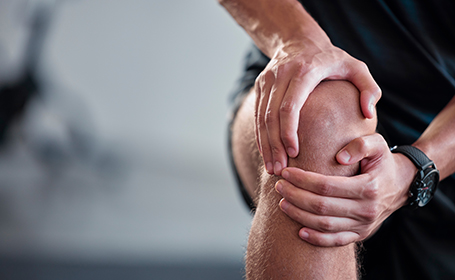
Injured cruciate ligament
Knee injuries – particularly to the anterior cruciate ligament – are relatively common, but they don’t need to mean an end to your sporting days. Here, we explain what happens when you injure your knee and how you can recover.
The knee is a complex joint – in fact it's actually three separate joints, with two types of cartilage and four main ligaments. Many people will experience some sort of knee pain or injury during their life, and this is often caused by a problem with their anterior cruciate ligament (ACL).
What and where is an ACL?
The cruciate ligaments cross over each other and sit in the middle of the knee joint – the anterior is in the front and the posterior at the back. Their role is to keep the knee stable, working together with other ligaments and muscles.
ACL injuries occur as a result of a contact or non-contact twisting of the knee.

A pain in the ACL
Your ACL is more susceptible to injuries than its posterior partner, and the majority of accidents are caused by sport – usually if there is an impact or unnatural motion while your foot is planted.
At St Edmunds Hospital, Consultant Orthopaedic Surgeon Andrew Dunn explains: "ACL injuries occur as a result of a contact or non-contact twisting of the knee.
"Patients often describe a 'pop' or a 'snap' that is associated with significant swelling. The pain is often so severe that patients fear they have broken their leg. It's difficult to put weight on the injured leg and if the injury occurs on the sports field the person involved will be unable to carry on playing."
Footballers are particularly susceptible to ACL injuries because of the dextrous movements involved as well as the dangers of tackling. With the UEFA Euro 2016 competition starting on 10 June this year, the pressure is on for European footballers to be in peak physical condition and avoid injuries that could see them missing the competition.
In just a six week period at the end of 2015, six Premier League footballers suffered serious cruciate ligament injuries that could jeopardise their ability to participate. And just last month, Italy international Claudio Marchisio suffered an ACL injury that means he's likely to miss out on the Euros.
So how are injuries treated?
Damage to your ACL needs professional attention and treatment – otherwise you may have repeated incidents of your knee 'giving way' A prompt assessment by an orthopaedic surgeon with experience managing soft tissue knee injuries is advisable and may be followed by an MRI scan of your knee to check the extent of the damage.
The bad news is that, once ruptured, your knee will remain unstable – it can't heal spontaneously or just by wearing a knee brace. But there are number of ways to treat an ACL injury and not all of them require surgery. Mr Dunn, a member of the International Society for Arthroscopy, Knee Surgery and Orthopaedic Sports Medicine, explains:
“With appropriate physiotherapy and rehabilitation, a large group of patients don't require further surgery to reconstruct the ACL.
"They can build up their muscles to stabilise the knee and can lead an active life, run in a straight line and go to the gym. Patients who have a sedentary job and are prepared to give up sports that involve twisting and turning can also avoid surgery.
"But patients whose job requires a stable knee when twisting and turning or those who wish to return to sports such as rugby, football, hockey or netball will, almost definitely, require an ACL reconstruction."
What happens during ACL surgery?
For those who need surgery on their ACL, the aim will be to replace the injured ACL with a graft taken from elsewhere in your body to strengthen the knee and stop it giving way in the future.
The graft usually comes from your hamstring tendons or the central third of the patella tendon (underneath your kneecap). Tunnels are drilled in the shin bone (tibia) and the thigh bone (femur) and the graft is then placed along the line of your ruptured ligament.
Advancements in surgery mean you can now rehabilitate without needing a brace or knee support.
But the good news is…
Advancements in surgery mean you can now rehabilitate without needing a brace or knee support. To regain your full level of fitness, you'll have to undergo post-operative rehabilitation – but this should see you returning to the sport you love within 9-12 months. Professional athletes, however, often go through an accelerated rehabilitation programme to get them ready to compete within six months.
"Physiotherapy, provided by an experienced physiotherapist, is essential if you want to return to full fitness. But damage to the ACL no longer means no more sport. Handled properly, patients have a great chance of getting back into sport action," says Mr Dunn.
Tags
How do I book an appointment?
If you're concerned about symptoms you're experiencing or require further information on this subject, talk to a GP or see an expert consultant at your local Circle Hospital.